Can Cats Have Autism?
Exploring the Intersection of Cats and Autism
The question 'Can cats have autism?' often sparks curiosity and misconceptions. While current scientific research definitively states that cats cannot be diagnosed with autism, their behaviors can sometimes resemble traits associated with autism in humans. Understanding these behaviors, the similarities, differences, and the therapeutic potential of cats for individuals on the autism spectrum, provides valuable insight into the complex world of animal and human neurodevelopmental disorders.
Can Cats Have Autism or Exhibit Autism-like Behaviors?
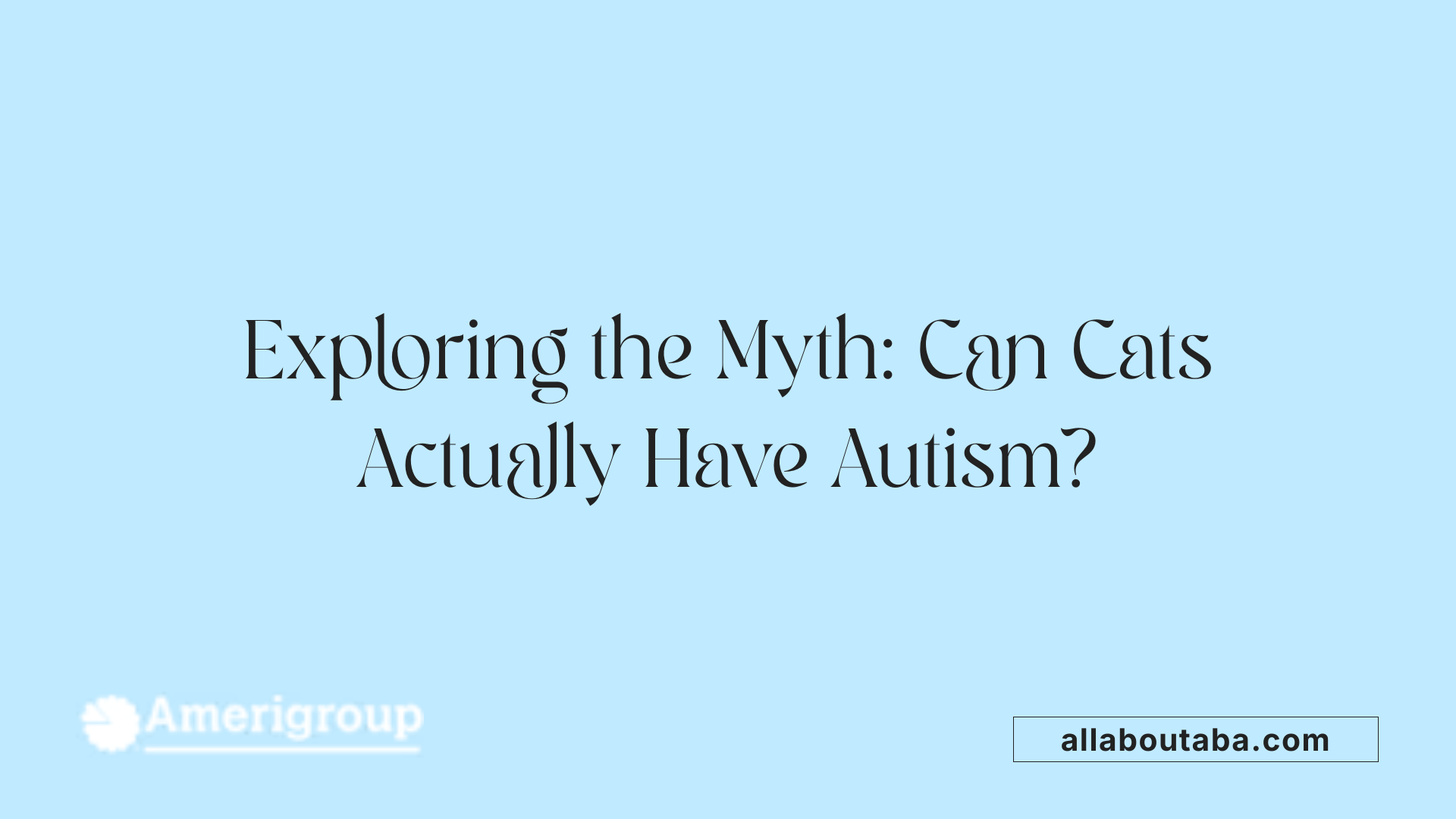
Is there scientific evidence that cats can have autism?
Currently, there is no scientific proof that cats can be diagnosed with autism or any autism spectrum disorder. Autism is a developmental condition primarily characterized by differences in sensory processing, social interaction, communication, and repetitive behaviors. These traits are well-documented in humans and some animal models studied for research purposes. However, cats do not display a broad range of behaviors that would clearly indicate autism as it is understood in people.
Cats often show behaviors that might look similar to certain autistic traits, but these are usually normal feline responses or related to health conditions. For example, a cat might groom excessively or withdraw from social interactions, but these actions could stem from stress, illness, or breed characteristics rather than a neurodevelopmental disorder.
Are there behavioral similarities between cats and autistic traits?
Many behaviors seen in cats can resemble some traits associated with autism in humans. Repetitive behaviors, such as pacing or excessive grooming, may appear similar to stereotypical actions sometimes seen in autistic individuals.
Some cats show sensitivities to light, sound, or touch, paralleling sensory sensitivities reported by autistic people. Social withdrawal or preference for solitude can be mistaken for social difficulties.
Nevertheless, these feline behaviors are generally due to environmental factors or health issues rather than indicators of autism. Unlike humans, cats do not have the cognitive complexity or neurological structure that allows for a diagnosis of autism.
In conclusion, while some feline behaviors mimic certain autistic traits, current scientific understanding suggests that cats cannot have autism. Their behaviors are best seen as part of normal feline diversity or responses to specific internal or external stimuli, not as signs of a neurodevelopmental condition.
Misconceptions About Autism in Pets, Especially Cats
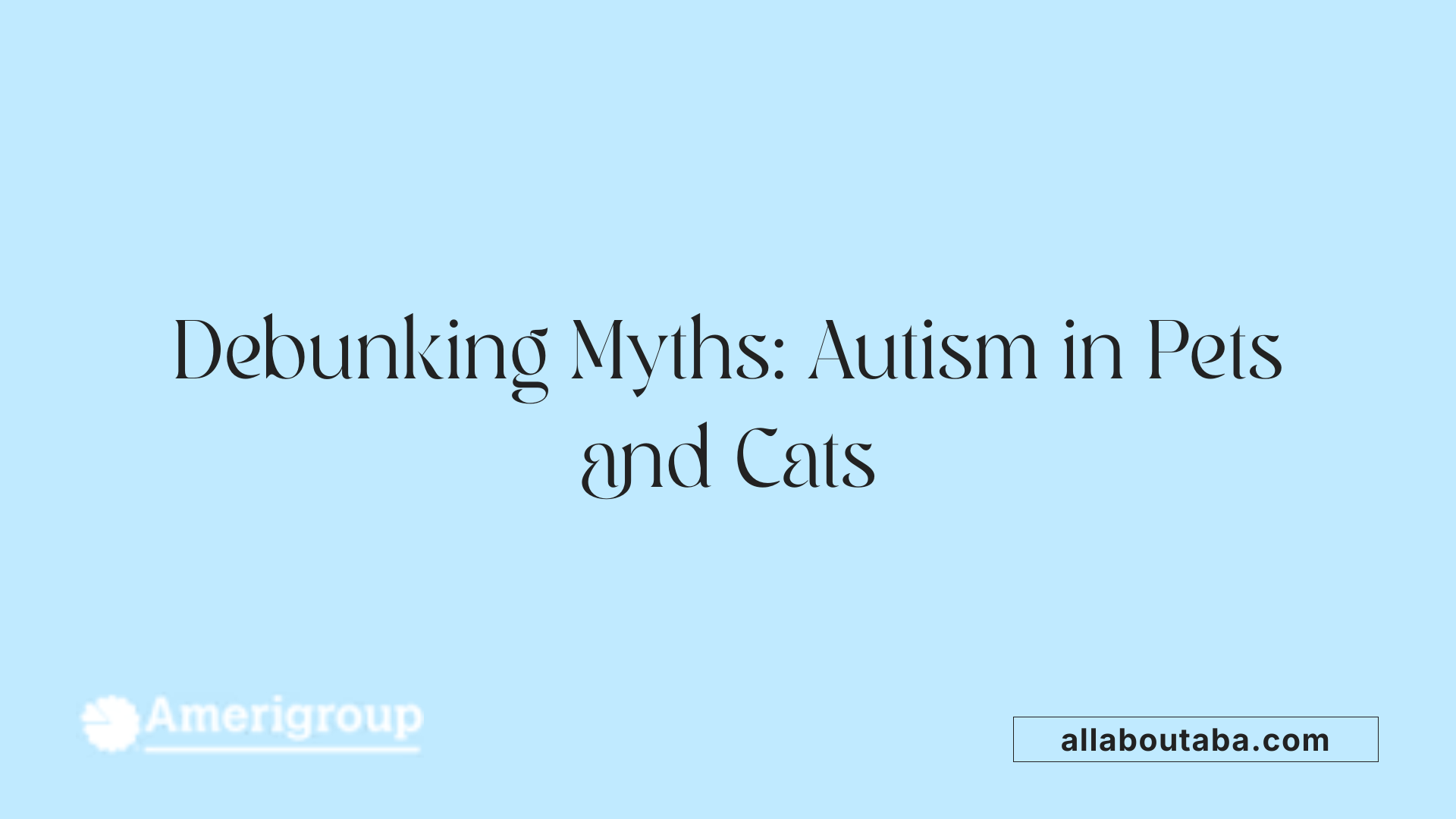
Are there misconceptions about autism in pets, especially cats?
Many people believe that animals, particularly cats, can have autism. However, autism is a neurodevelopmental condition specific to humans, characterized by traits such as social communication challenges, sensory sensitivities, and repetitive behaviors. These traits are not diagnostic in animals.
While some behaviors in cats — like obsessive grooming, repetitive sounds, or anxiety — may resemble human autistic behaviors, these are usually linked to health issues, stress, or species-specific tendencies. For instance, a cat might groom excessively due to skin irritation or stress, not because it has autism.
Research shows that animals like cats, dogs, or guinea pigs do not have autism. Instead, they can perceive human differences and respond accordingly, often providing comfort and support. Cats, in particular, tend to respond favorably to children with autism and can help in teaching social skills and providing emotional stability.
The myth that pets can have autism persists partly because behaviors such as hypersensitivity or repetitive actions are similar to some human traits. Nonetheless, diagnosing autism in animals is scientifically inaccurate. Pets are valuable companions for many with autism, offering friendship and stability, but they do not have the condition themselves.
Recognizing these distinctions helps promote a realistic appreciation of how animals support individuals with autism, without misconceptions about their own health or behavioral states.
Signs and Symptoms of Autistic Tendencies in Cats
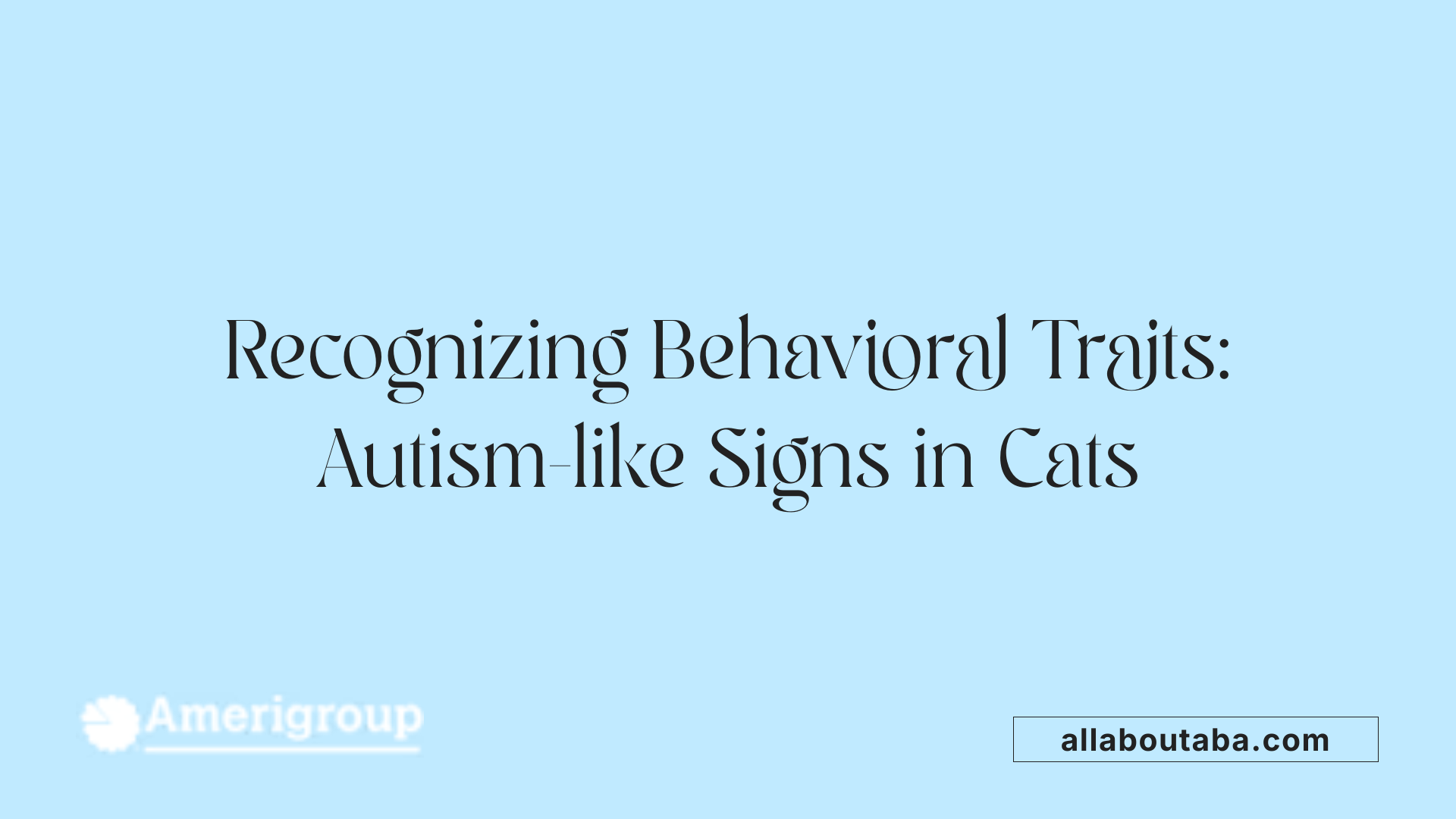
What are the signs and symptoms of autistic tendencies in cats?
Cats displaying behaviors that resemble autism might show signs such as withdrawal from social interactions, preferring to be alone most of the time. They may engage in repetitive actions like pacing, rubbing, or grooming themselves excessively. These cats often exhibit altered responses to their environment, such as being hypersensitive or hyposensitive to stimuli like sounds, lights, or touch.
Other indicators include unusual vocalizations, head pressing against surfaces, or showing signs of anxiety, especially in new or stressful situations. Some cats may also become unresponsive or display a lack of typical curiosity.
It's important to remember that these behaviors are not definitive proof of autism. Many health issues, stressors, or environmental factors can cause similar behaviors. Therefore, consulting with a veterinarian or a feline behaviorist is crucial for an accurate assessment.
While these traits can help in understanding feline behavior, attributing them solely to autism is limited. Proper diagnosis involves ruling out medical conditions and considering the individual cat's history and environment.
Limitations of attributing these behaviors to autism
Autistic tendencies in cats are a controversial and not scientifically established diagnosis. Behaviors similar to autism can arise from various causes, such as health problems, past trauma, or environmental stress.
Therefore, it's important not to jump to conclusions based solely on observed traits. Each cat is unique, and behaviors should be evaluated with professional guidance to ensure proper care and support.
Understanding these behaviors can improve our approach to feline care, making interactions more positive and tailored to each cat's needs.
Understanding Why Cats Cannot Be Diagnosed with Autism
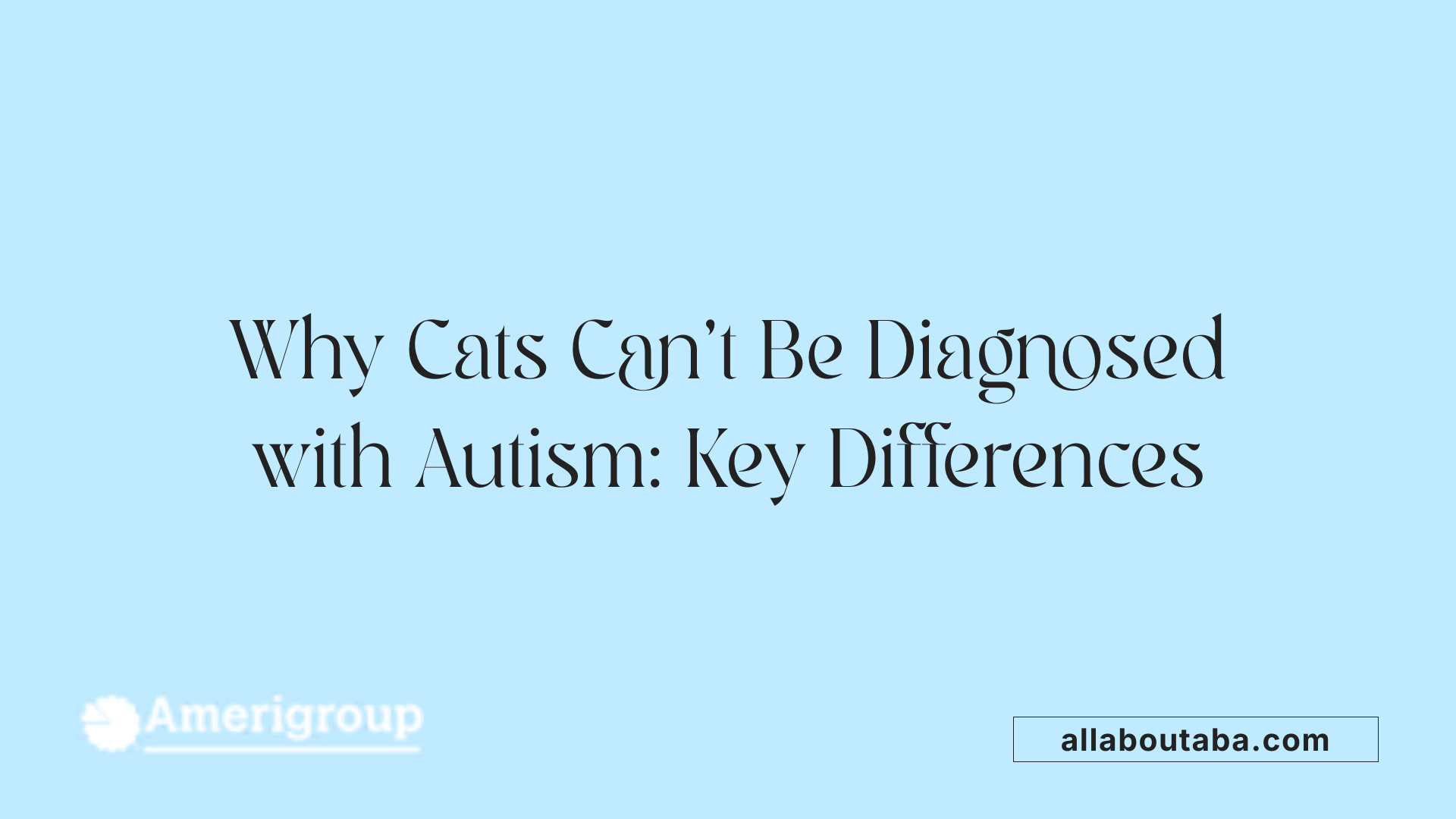
Why can't cats be diagnosed with autism, and how can similar behaviors be differentiated?
Autism is a complex neurodevelopmental disorder with specific diagnostic criteria that are based on human cognitive, social, and communication abilities. These criteria involve detailed assessments of language development, social interactions, and repetitive behaviors that are tailored to human traits. Since animals like cats cannot engage in language or social cognition in ways humans do, they cannot be diagnosed with autism.
Many behaviors observed in cats, such as avoiding social interaction or repetitive grooming, may resemble autistic traits. However, these behaviors often stem from different causes, including stress, illness, environmental changes, or individual temperament. For example, a cat avoiding contact may be stressed or unwell rather than exhibiting a sign of a neurodevelopmental condition.
Research uses animal models, especially rodents, to explore autism-related behaviors. These models involve genetic modifications or environmental manipulations designed to replicate specific aspects of autism, such as social deficits or repetitive actions. They allow scientists to investigate the underlying mechanisms and distinguish behaviors caused by autism from those resulting from other factors.
In essence, while cats may display behaviors that superficially resemble autism, these are not reliable indicators of the condition. Proper differentiation involves considering health status, stress levels, and environmental influences, rather than attributing such behaviors to autism itself.
More details can be found by searching for "Differentiating feline behaviors from autism" to better understand how these behaviors can be interpreted and distinguished in practice.
Therapeutic Benefits of Cats for Autistic Individuals
Interaction with cats offers numerous emotional and social benefits for individuals on the autism spectrum. Cats provide a calming presence, often helping reduce feelings of stress, anxiety, and depression. Touching and petting cats can release oxytocin, a hormone associated with bonding and relaxation, fostering a sense of comfort.
For many autistic individuals, animals are easier to connect with than humans, especially because cats exhibit facial expressions and behaviors that are more Animal-like, which some people with autism find less overwhelming. These interactions can promote emotional regulation and help develop social skills, such as empathy and responsibility.
Research supports these benefits. Studies show that working with cats can result in lower cortisol levels and slower heart rates, indicating reduced stress. Additionally, interaction with cats has been linked to improved social awareness, communication skills, and a decrease in problem behaviors like hyperactivity and inattentiveness.
How can cats assist autistic individuals, and what are the benefits of using cats as support animals?
Cats can serve as comforting companions that provide emotional stability, especially for children with autism. They are nonjudgmental, which helps children relax and share a bond more easily. This gentle connection can boost confidence, social interaction, and the ability to learn empathy and compassion.
In therapy settings, cats can facilitate learning routines, teach responsibility, and help with emotional regulation. They also offer consistent companionship that can mitigate separation anxiety.
Research from veterinary and human interaction centers highlights the positive impact of cats. For example, studies have shown that adopting a cat leads to increased empathy, fewer behavioral issues, and decreased separation anxiety in children with autism. Some programs even train cats as assistance animals to help with daily routines, easing transitions, recognizing repetitive behaviors, and preventing meltdowns.
While cats do not perform specialized tasks like service dogs, their presence alone offers significant emotional support and enhances well-being for many autistic individuals. Choosing a calm, temperament-tested cat can create a stable, soothing environment conducive to emotional and social growth.
More about the support role of cats
| Trait or Behavior | Benefit for Autistic Individuals | Additional Details |
|---|---|---|
| Calm Temperament | Reduces stress and promotes relaxation | Selected for stability through temperament testing |
| Repetitive behaviors | Can be mirrored or helped by calming feline behaviors | Observed behaviors include grooming, purring, and slow blinking |
| Routine and Rituals | Helps establish predictable daily activities | Cats can be incorporated into routines to increase consistency |
| Emotional Comfort | Decreases feelings of loneliness and anxiety | Non-judgmental nature makes them approachable and soothing |
| Improving social skills | Facilitates learning empathy and communication | Pets often encourage eye contact and gentle interactions |
Considerations
While the benefits are substantial, owning a cat requires careful planning. Care expenses, time commitment, and understanding cat behaviors are important. Some cats may experience stress or anxiety themselves, which could affect their behavior. Proper selection and training ensure positive interactions.
Overall, cats serve as compassionate, therapeutic companions. Their consistent warmth and gentle nature support emotional well-being and social development, making them valuable allies for many on the autism spectrum.
Educational Resources Available for Autism and Feline Behavior
Numerous educational resources are accessible for those interested in understanding the connection between autism and feline behavior. These include books such as 'All Cats Have Asperger Syndrome' by Kathy Hoopmann, which uses photographs of cats to illustrate traits associated with autism spectrum conditions. Scholarly articles and research papers delve into the effects of animal-assisted therapy, highlighting how interactions with cats can foster social skills, emotional regulation, and stress reduction among autistic individuals.
Organizations like the Human-Animal Bond Research Institute (HABRI) offer valuable information on the benefits of companion animals. They showcase research demonstrating that cats can help reduce feelings of loneliness, improve social interaction, and provide emotional comfort to children with autism. Moreover, studies have shown that animals like cats are often preferred by autistic individuals due to their predictable behaviors and non-judgmental nature.
Animal-assisted therapy, including interactions with cats, has been scientifically studied and found to enhance social skills, decrease anxiety, and improve overall well-being. While recognizing that animals cannot replicate human neural traits, research emphasizes the therapeutic value of understanding feline behaviors to develop better support strategies for autistic individuals. Educational content from reputable organizations often discusses the scientific insights about animal behavior and how it can be harnessed in therapeutic settings.
In sum, these resources—ranging from books and research articles to organizational materials—offer comprehensive guidance on how feline interactions can support the development and well-being of people on the autism spectrum, fostering greater understanding and acceptance.
The Role of Animal Models in Autism Research
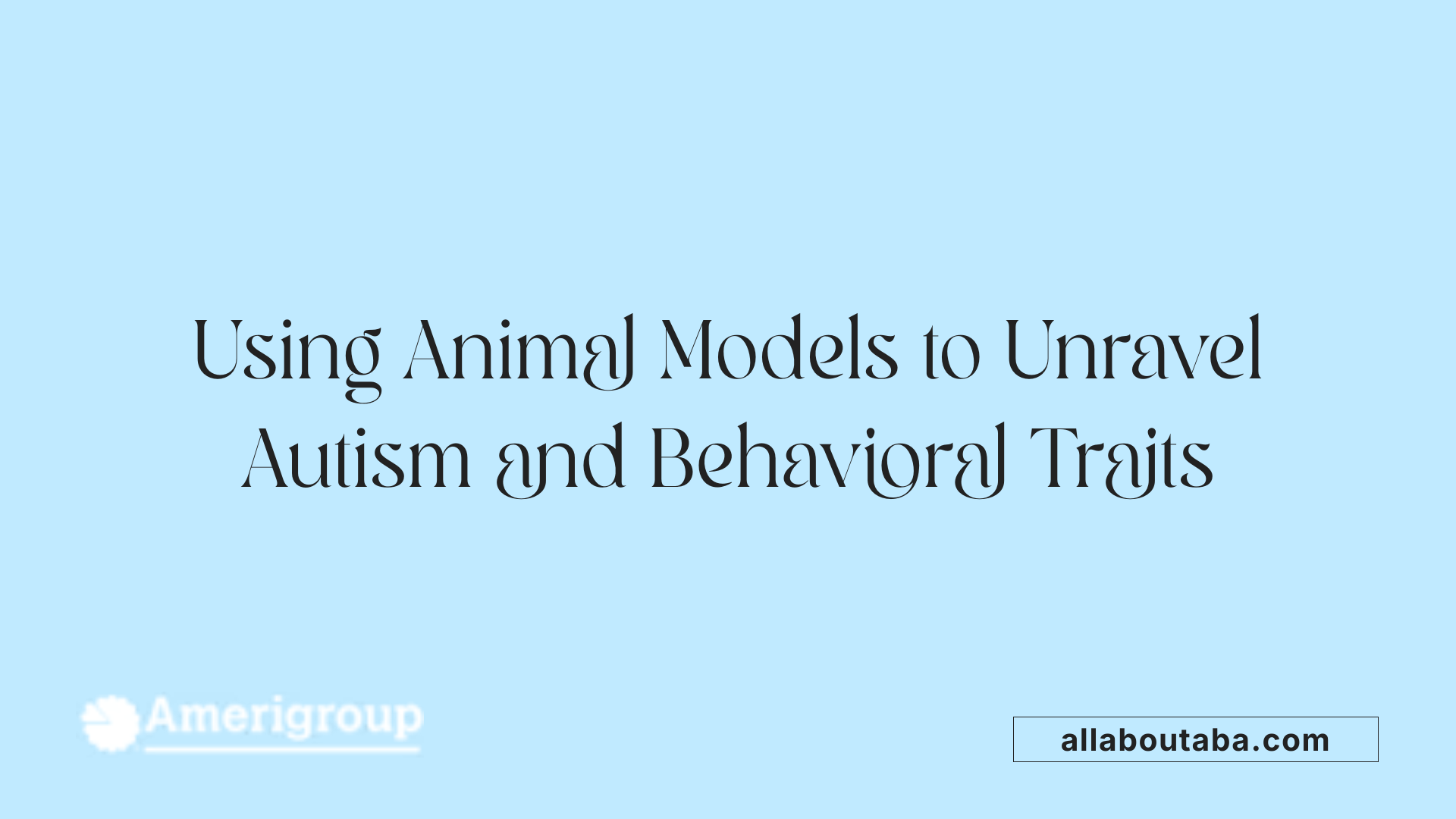
How can research and animal models help differentiate behaviors caused by autism from other issues in animals?
Research from Craig R. Evans (2012-2013) highlights that high-functioning autistic individuals often experience anxiety as their main source of stress. Interestingly, interaction with pets like cats has shown to alleviate such anxiety, offering a calming influence.
In scientific research, various animal models, primarily rodents, are used to explore autism's complexities. These animals are genetically engineered or exposed to specific environments to exhibit behaviors comparable to autism traits, like social deficits or repetitive actions. These models enable scientists to investigate the roots of such behaviors under controlled conditions.
A crucial aspect of this research is distinguishing behaviors caused by autism from those arising due to other issues such as illness or stress. For example, if a rodent displays repetitive grooming, researchers assess whether this is a sign of a structured autistic-like behavior or a response to discomfort.
Through this approach, scientists better understand the biological pathways involved in autism, which may also relate to certain animal behaviors. While animals like cats do not develop autism per se, studying their behaviors—such as OCD-like grooming or stress responses—can shed light on similar symptoms in humans.
Using these models helps ensure that observed behaviors are accurately associated with specific genetic or environmental factors, providing insights into potential interventions. This research enhances our understanding of neurodevelopmental differences, paving the way for targeted therapies and support strategies for autistic individuals.
Conclusion: Clarifying the Connection Between Cats and Autism
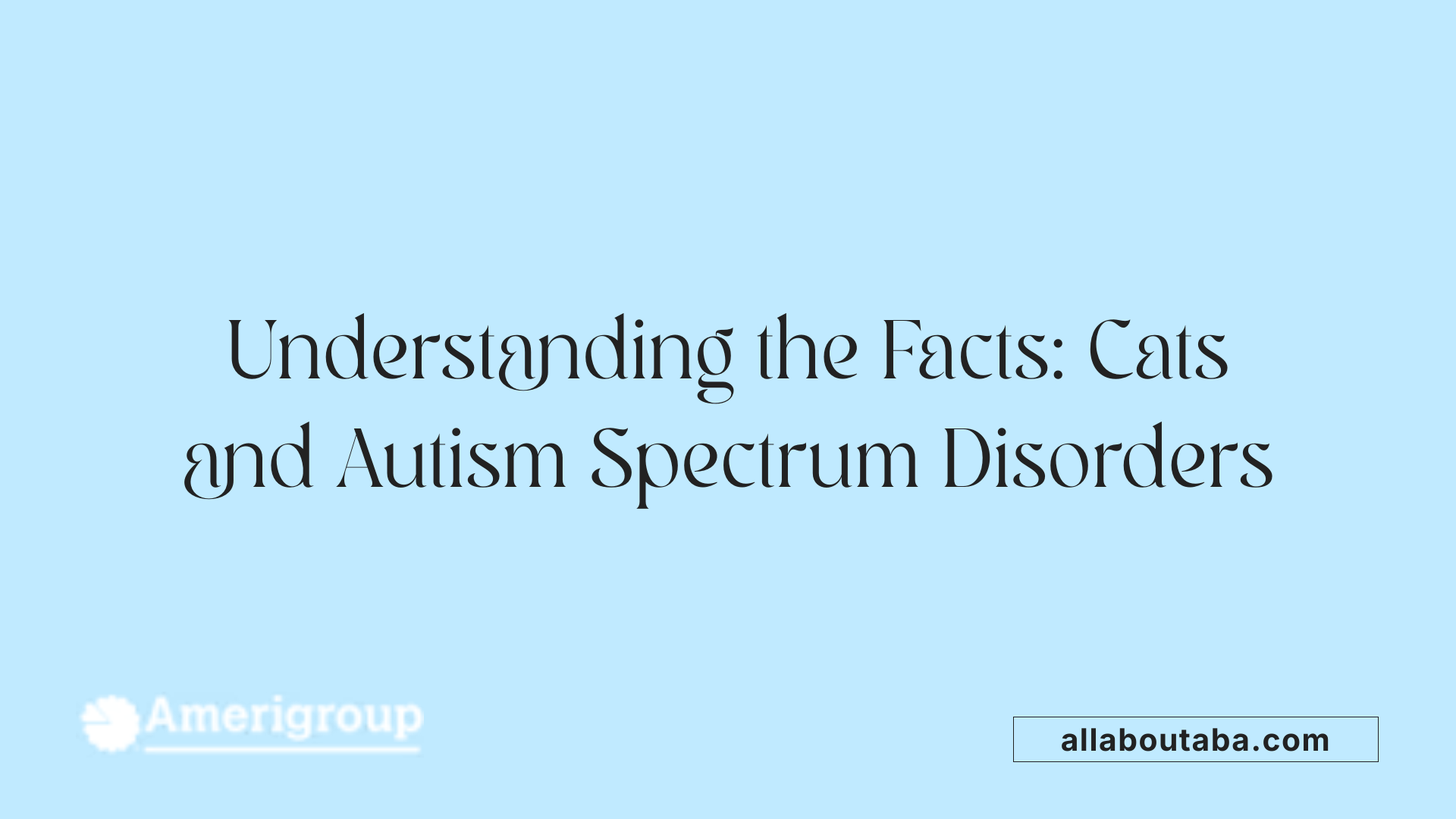
What is the current scientific understanding of the relationship between cats and autism?
Research indicates that there is a significant bond between autistic individuals and cats, often due to the animals’ non-judgmental nature and ability to respond to specific sensory and emotional needs. Interaction with cats can help reduce stress, anxiety, and improve social skills in children and adults on the autism spectrum. Studies have shown that selecting calm, well-tempered cats for therapy provides benefits such as increased empathy, decreased separation anxiety, and fewer problem behaviors. Animal-assisted therapy involving cats is recognized for its positive impact on emotional regulation and social interaction.
Why is accurate information and compassionate understanding important in this context?
Understanding the true nature of animals’ behaviors and the ways they can support autistic individuals promotes realistic expectations and safe, effective interactions. Despite popular metaphorical comparisons, cats cannot be diagnosed with autism because it is a human-specific neurodevelopmental condition. They may exhibit behaviors that resemble some autism traits, such as repetitive actions or social withdrawal, but these are often caused by stressful environments, illness, or anxiety. Recognizing this helps prevent misconceptions that could lead to mistreatment or disappointment, emphasizing empathy and respect for both humans and animals.
| Topic | Explanation | Additional Notes |
|---|---|---|
| Autism diagnosis in animals | Not possible | Autism is a human condition with complex social and communicative components |
| Animal models of autism | Used in research | Rodents and other animals are engineered or exposed to environmental factors to study autism-like behaviors |
| Cats and autism behaviors | Similar but not identical | Repetitive or withdrawn behaviors in cats are not diagnostic and can stem from other causes |
| Benefits of cats for autistic individuals | Emotional regulation, social skills, stress relief | Supported by research and therapy programs |
| Precautions | Care needs, stress, and health issues | Important for successful interaction and welfare |
In summary, while cats can play a therapeutic role for autistic individuals, it is essential to understand that behaviors they exhibit are not diagnostic of autism. Compassionate use of animals for support, paired with accurate scientific understanding, fosters more meaningful and safe relationships.
Final Thoughts and Future Directions
While the idea of cats having autism remains unsupported by scientific evidence, understanding feline behaviors and their resemblance to certain traits associated with autism is valuable for pet owners and caregivers. Cats can serve as therapeutic support, helping individuals with autism spectrum disorder by reducing stress and promoting emotional well-being. The use of animal-assisted therapy highlights the importance of accurate knowledge and humane treatment, ensuring that expectations are realistic and that these animals are appreciated for their unique qualities. Continued research into the human-animal bond and the development of support strategies will enhance the benefits for both pets and individuals on the autism spectrum, emphasizing empathy, patience, and scientific rigor.
References
- All Cats Have Asperger Syndrome: Hoopmann, Kathy - Amazon.com
- Cats and autistic people: scoping out the purrfect pair?
- Explaining Autism: With Cats - Just Keep Stimming
- Can cats have autism? - The South African
- Autism and cats - Cat Friendly
- The Camouflaging Autistic Traits Questionnaire (CAT-Q)
- How Cats are Helping Children with Autism
- Animal Models of Autism Spectrum Disorders and Behavioral ...
Other articles
Recent articles

How Schools Can Support Autistic Students In Career Prep

Best Strategies For Autism-Friendly Event Planning

Understanding Noncontingent Reinforcement In Autism Behavior Plans

How Drama Therapy Benefits Autistic Individuals

Best Practices For Autism-Friendly Fitness And Recreation Centers

Best Ways To Promote Healthy Social Media Use For Autistic Teens

How To Help Autistic Children Cope With Public Speaking

Autism And Strategies For Managing Unexpected Changes

Best Podcasts About Autism For Parents And Educators

Autism And The Impact Of Seasonal Changes On Behavior

The Role Of Diet In Managing Co-Occurring Conditions With Autism

Sleep Challenges In Autism And Practical Solutions

Best Ways To Build Daily Routines For Autistic Children

Best Practices For Supporting Autistic Entrepreneurs

Autism And Strategies For Navigating Large Social Gatherings

Adaptive Sports And Recreational Activities For People With Autism

Autism And The Benefits Of Story-Based Learning Activities

Understanding The Role Of Play In Autism Development

Autism And The Impact Of Environmental Noise On Learning

How To Create Autism-Friendly Community Spaces

Autism And Chronic Health Conditions: What To Know

The Role Of Care Managers In Autism Life Planning

How To Teach Social Boundaries To Autistic Children

How Autistic Individuals Experience Empathy Differently

How To Support Autistic Employees In Remote Work Settings

Autism And The Relationship Between Motor Skills And Learning

How To Create Community Resource Guides For Autism Families

How To Teach Daily Living Skills To Autistic Teens

Autism And The Impact Of Mind-Body Practices On Stress Reduction

Autism And The Benefits Of Outdoor Group Activities

How To Create Autism-Friendly Sensory Paths In Schools

Best Practices For Autism-Friendly Park And Recreation Areas

Autism And Strategies For Reducing School Refusal

Supporting Autistic Individuals In Public Speaking

The Role Of Diet In Managing Autism Symptoms

The Benefits Of Gardening Clubs For Autism Social Development

How To Prepare Autistic Children For Dental Visits

Autism And Employment: Career Paths That Work

Best Practices For Autism-Friendly Hotels And Lodging

The Impact Of Screen Time On Autism Development

Autism Screening Tools For Early Childhood

The Role Of Physical Exercise In Autism Therapy

Best Strategies For Supporting Autistic College Students

The Role Of Technology In Autism Early Detection

Sensory-Friendly Classroom Design Ideas For Autistic Students

The Role Of Speech Therapy In Building Social Communication Skills

Best Strategies For Handling Autistic Burnout In Adults

Autism And The Importance Of Predictability In Routine

Autism And Peer Education: Teaching Acceptance In Schools

Best Practices For Sensory-Friendly Libraries And Reading Rooms

Self-Advocacy Skills For Autistic Adults

The Role Of Technology In Autism Peer Communication

Promoting Physical Activity In Children With Autism

How To Prepare Autistic Children For Medical Procedures

The Role Of Social Media In Autism Advocacy And Awareness

The Impact Of Sensory Rooms In Public Facilities For Autism

How To Create An Autism-Friendly Holiday Celebration

Best Practices For Inclusive Education For Autistic Students

Autism And Mental Health: Recognizing Signs Of Distress

Best Practices For Sensory-Friendly Waiting Rooms

The Role Of Teachers In Early Autism Red Flag Identification

Autism-Friendly Housing Design Features

Autism-Friendly Housing Design Features

How Environmental Modifications Improve Autism Outcomes

Autism And Technology-Based Learning Tools

Supporting Autistic Children Through Changes In Routine

The Link Between Autism And Working Memory Challenges

Best Practices For Autism-Friendly Cooking Classes

Autism And The Benefits Of Structured Music Lessons

Best Books To Teach Kids About Autism Acceptance

Sensory Diets And Their Benefits For Autism Management

How To Prepare Autistic Teens For Driver’s Education

How To Teach Autistic Teens About Healthy Relationships

The Role Of Visual Prompts In Building Daily Habits For Autism

Addressing Sleep Regression In Children With Autism

Understanding Social Stories And How They Help Autistic Children

Navigating Insurance Coverage For Autism Therapy Services

How To Prepare Autistic Adults For Independent Travel

Supporting Autistic Individuals In Volunteer Work

How Mindfulness Practices Can Support Autism Well-Being

Understanding Hyperfocus And Special Interests In Autism

Understanding Stimming As A Self-Regulation Tool

Sensory-Based Interventions For Autism At Home

Best Ways To Introduce Self-Advocacy In Autistic Teens

Best Ways To Support Autistic Employees In Customer Service Roles

Best Practices For Autism-Friendly Volunteer Programs

Autism And The Benefits Of Sensory Play For Emotional Growth

Autism And Strategies For Building Peer Relationships

Understanding How Autism Affects Memory Processing

Autism And Strategies For Building Coping Skills In Teens

The Role Of Parent Training In Autism Intervention Programs

Autism-Friendly Workplace Accommodations

Using Visual Timers For Autism Time Management

What Is ABA Therapy?

Autism and Sleep

Do Plastic Toys Cause Autism?

Autism Facial Expressions

Autism and Motor Skills

Which Parent Carries The Autism Gene?

Autism Symbols & Colors
We’re All About You, Your Family, and Your Child

